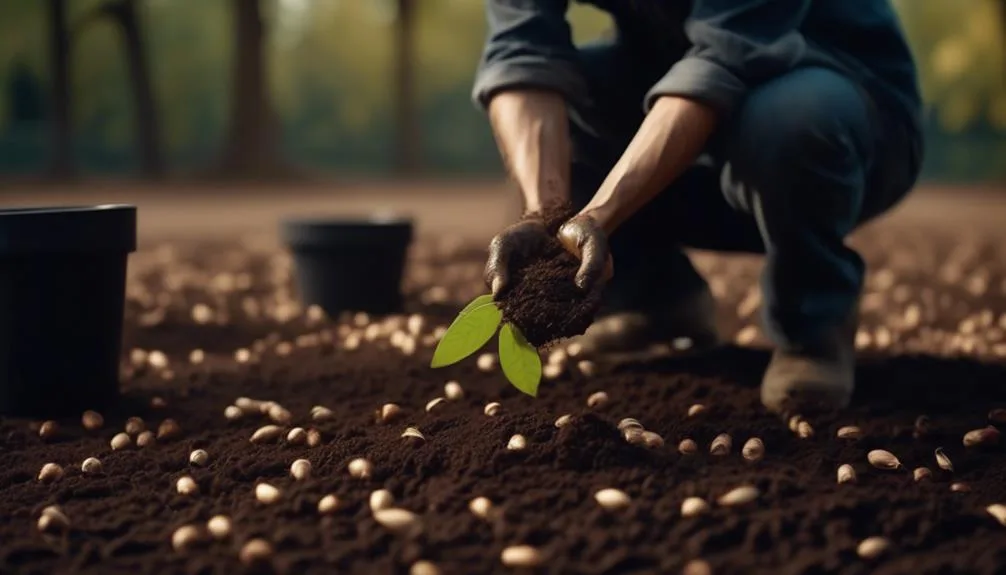Are you fascinated by the grand hickory trees in your area and want to grow your own from seeds?
Propagating hickory trees is a fulfilling but meticulous process. This guide will cover selecting, preparing, planting, and caring for hickory tree seeds.
Whether you're a seasoned gardener or a beginner, this process offers valuable insights into tree propagation and the natural world. Get ready to start your hickory tree propagation journey with these essential steps.
Selecting and Collecting Hickory Tree Seeds
Selecting and collecting hickory tree seeds is a crucial step in propagating new trees for your landscape or forest. When selecting seeds, opt for healthy, mature nuts that have fallen from the tree. Look for nuts with intact shells and without any signs of damage or disease.
After collection, store the seeds in a cool, dry place to maintain their viability. Hickory tree seeds can be stored in airtight containers or plastic bags in the refrigerator for several months.
To test the viability of the seeds, conduct a simple float test by placing them in water. Discard any seeds that float as they're likely not viable.
Proper selection, collection, and storage of hickory tree seeds are essential for successful propagation.
Preparing the Seeds for Planting
After ensuring you have collected healthy, mature hickory tree seeds, the next step is to prepare them for planting. Follow these steps to ensure successful propagation:
- Cleaning: Gently clean the seeds by removing any remaining fruit or debris. Rinse them in water and allow them to air dry.
- Soaking seeds: Place the seeds in a container of room temperature water and let them soak for 24-48 hours. This helps to soften the seed coat and improve germination.
- Seed scarification: For species with hard seed coats, scarification can be done by gently nicking or sanding the seed coat to help water penetrate and initiate germination.
- Germination techniques: Consider using methods such as stratification (exposing seeds to cold, moist conditions) to mimic natural conditions and promote germination.
Planting the Hickory Tree Seeds
When planting hickory tree seeds, ensure you choose a suitable location with well-draining soil and ample sunlight for optimal growth. The soil should be slightly acidic to neutral pH, and it's important to avoid waterlogged areas as hickory trees prefer well-drained soil conditions. Once you have the right location, it's time to plant the seeds. Create a small hole about 1 inch deep, place the seed inside, and cover it with soil. After planting, water the soil thoroughly. Ensure the soil remains consistently moist but not waterlogged. Here's a helpful guide for the watering schedule:
| Week | Watering Frequency |
|---|---|
| 1-2 | Every 2-3 days |
| 3-4 | Once a week |
| 5 onwards | As needed |
Following this watering schedule will help the hickory tree seeds to establish and grow successfully.
Caring for Young Hickory Tree Seedlings
To ensure the successful growth of your young hickory tree seedlings, maintaining a consistent watering schedule and providing proper sunlight and soil conditions, as discussed in the previous subtopic, is essential.
Here are some essential care tips for your young hickory tree seedlings:
- Watering Schedule: Water the seedlings regularly, ensuring that the soil is consistently moist but not waterlogged. Adjust the watering frequency based on weather conditions and the moisture level of the soil.
- Sunlight Requirements: Place the seedlings in an area that receives full sunlight for at least 6-8 hours a day. Ensure they're protected from strong winds and extreme heat.
- Soil Conditions: Use well-draining soil with a good mix of organic matter. Avoid compacted or waterlogged soil.
- Protection: Shield the seedlings from pests and animals that may damage or eat the young plants.
Transplanting Hickory Tree Seedlings
Consider carefully selecting a new location with optimal growing conditions before transplanting your hickory tree seedlings. This will ensure the best chances for successful root development and healthy growth. When transplanting, choose a site with well-draining soil that retains adequate moisture for sustained root growth. Here's a helpful table to guide your transplanting process:
| Transplanting Tips | Description |
|---|---|
| Selecting the Site | Choose a location with optimal growing conditions, including well-draining soil. |
| Digging the Hole | Ensure the hole is deep and wide enough to accommodate the root system without cramping. |
| Watering | Maintain soil moisture by watering the seedling regularly, especially during its initial establishment. |
| Mulching | Apply a layer of mulch around the base of the seedling to help retain soil moisture and regulate temperature. |
Conclusion
In nurturing healthy seeds and tender seedlings, you're sowing the potential for beauty and benefit right in your own backyard.
With care and dedication, hickory trees will flourish, enriching your surroundings and rewarding your efforts.
Happy planting!
Mark Hoffman is a dedicated arborist and tree care specialist with over a decade of experience. His love for trees began when he visited Yosemite National Park as a teenager and was awestruck by the giant sequoias. Mark pursued his passion by studying forestry at Michigan Technological University, where he earned a Bachelor of Science degree.
Since then, he has worked tirelessly in the field of arboriculture, helping to preserve and protect trees in his community. His expertise and dedication have made him a respected leader in the industry and a valuable resource for anyone seeking advice on tree care.
